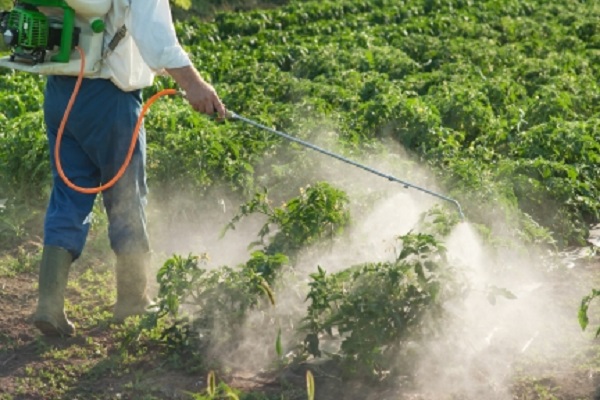 The amazing thing is that in the struggle for survival, a person once invented a vegetable garden and to this day is making stocks in case of economic or financial disasters. At the same time, there is a struggle in the vegetable fields, where the ubiquitous weeds are trying every season to prevail over cultivated plants.
The amazing thing is that in the struggle for survival, a person once invented a vegetable garden and to this day is making stocks in case of economic or financial disasters. At the same time, there is a struggle in the vegetable fields, where the ubiquitous weeds are trying every season to prevail over cultivated plants.
However, in this war, “grassy villains” are more likely to win because of the high survivability threshold. Therefore, people who have mastered the agricultural industry have to invent more and more new ways to combat hostile plants. And if earlier gardeners needed to weary themselves with manual weeding, now a chemical attack or herbicides has become the most effective way to destroy weeds. Who are they - assistants to the harvesting seasons, and what preparations for weeds on potatoes are considered the most effective?
Content
Potato Herbicides: General Features
We nevertheless decided to talk about the effectiveness of herbicides by the example of potatoes, since for our country it is truly considered the second bread. Stocking up potatoes for the winter means not worrying about your diet or the grocery stock of the population when it comes to potato fields for a commercial purpose.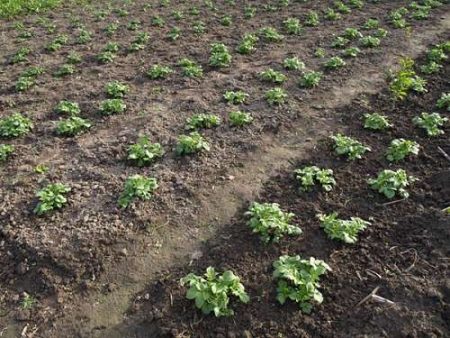
And if we still try to process small vegetable gardens in summer cottages mechanically, then on large-scale plantings it is not possible to deal with weeds manually. Until you reach the end of the first bed, harmful grass will appear at the beginning of it. Therefore, do not experiment with your crop and it’s time to use the modern, proven method of chemical weeding - herbicides.
According to their effect on plants, herbicides, in turn, are divided into:
- preparations continuous actionwhen the chemical composition destroys the vegetation indiscriminately;
- selective or selective herbicidesaimed at destroying a certain kind of weed.
In the first case, chemical treatment is applied in areas of industrial importance, as well as in the area of aerodromes, highways and railways or deforestation. From which it follows that such herbicides are not suitable for potato fields.
But selective herbicide for potatoes is a “smart” chemical that identifies the enemy in the face and fights it, and not all the vegetation combined.
But due to the fact that the problem of clogging of productive fields has not yet exhausted itself, every year manufacturers offer more and more varieties of chemical weeding.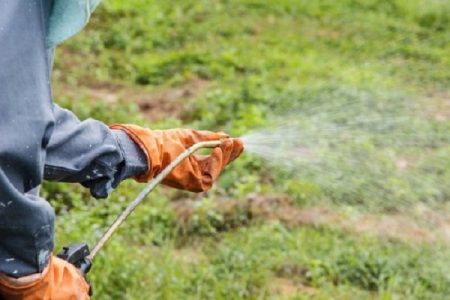
Selective herbicides and their varieties
Well, as in any war, in order to defeat the enemy you need to use a strategy. A well-designed destruction system always gives the best results.In our case, a strategic plan may involve the use of contact or systemic drugs. What is their difference?
- Contact herbicides - This is a type of chemical weeding, acting on the principle of burning stems and leaves of weed. That is, herbicides of this species kill the tops of the plant without reaching the root system. However, due to the fact that the roots of weeds lose the products of photosynthesis, they themselves can no longer exist for a long time and die after some time.
This method is considered very effective for plants that have lived 1 or 2 seasons. For example, for garden sow thistle, bindweed, shepherd’s bag or wood lice.
- And there are still drugs systemic actionkilling the vascular structure of the weed. That is, the chemical composition of the drug reaches the roots of the plant, blocks the growth points and prevents the cells from dividing. This ability allows you to hit perennial weed grass such as wheatgrass or horsetail, whose root system is already quite powerful.
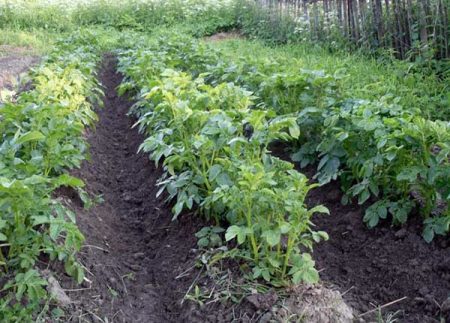
Moreover, herbicides are divided into soil preparations and leaf. That is, in the first case, chemicals in the form of granules or during irrigation are introduced into the soil 5-10 cm deep. This procedure is performed before potato planting or a few days after it.
Accordingly, leaf herbicides affect the apical part of the vegetation.
If you are a specialist in the agricultural industry, then, most likely, you have already learned how to choose and use herbicides from weeds for potatoes. But beginners usually have a whole list of questions. What herbicide to process potatoes after germination? What "do"? Do you need mechanical after using chemical weeding? How do herbicides affect potatoes? In the end, what drugs have proven their worth?
Potato chemical weeding: preparations
And so we move from theory to action and highlight the most effective and popular herbicides among the large selection of modern drugs.
Selective herbicide "Zenkor"
This is the drug that is the most effective in the fight against annual dicotyledonous plants. It is used both for soil cultivation of beds and for surface treatment through weed leaves. According to the method of exposure, the drug is a blocker of nutrients, water and sunlight for weed grass. The most effective "Zenkor" is considered to be a doctor, field mustard, chamomile, blue cornflower, pyroxis, stellate middle and garden thistle in the fight against haze. It is also a very high quality herbicide against field bindweed on potatoes.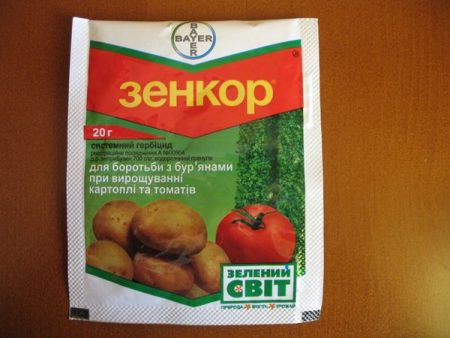
In order for the drug to work most efficiently, experts recommend using it at a temperature of 20 - 25 degrees. Moreover, at a time when potato sprouts have not yet appeared on the surface of the soil, and weeds have already sprouted.
The active ingredient of the drug is metribuzin, formed into water-soluble granules. The manufacturer offers us a package of 20 and 100 grams, but it should be purchased after determining the type of soil. So for light soil the lowest consumption of 5g is assumed. per hundred square meters. For medium-sized soil, you need to use a double dose of the drug, but for complex - heavy soils, at least 15 grams are used. per hundred square meters.
Herbitox selective drug
When wondering how to spray potatoes from weeds, you can give preference to such a drug as Herbitox.Like its previous "counterpart", this herbicide is the most effective in the fight against annual dicotyledonous plants. According to the method of exposure, it is used for the aboveground treatment of weed sprouts, during which it blocks the process of photosynthesis. Weeds such as field mustard, ragweed, ragweed, cabbage, stinging nettle, pikulnik, wild radish, medicinal dandelion, shiritsa, quinoa, common hedgehog and others are best exposed to the drug.
The most favorable environment for the operation of the herbicide is warm weather conditions with temperatures from 18 to 30 degrees without precipitation. Moreover, weather forecasts should be viewed a week before the planned chemical weeding. Since within 6 days after processing the bed should remain dry.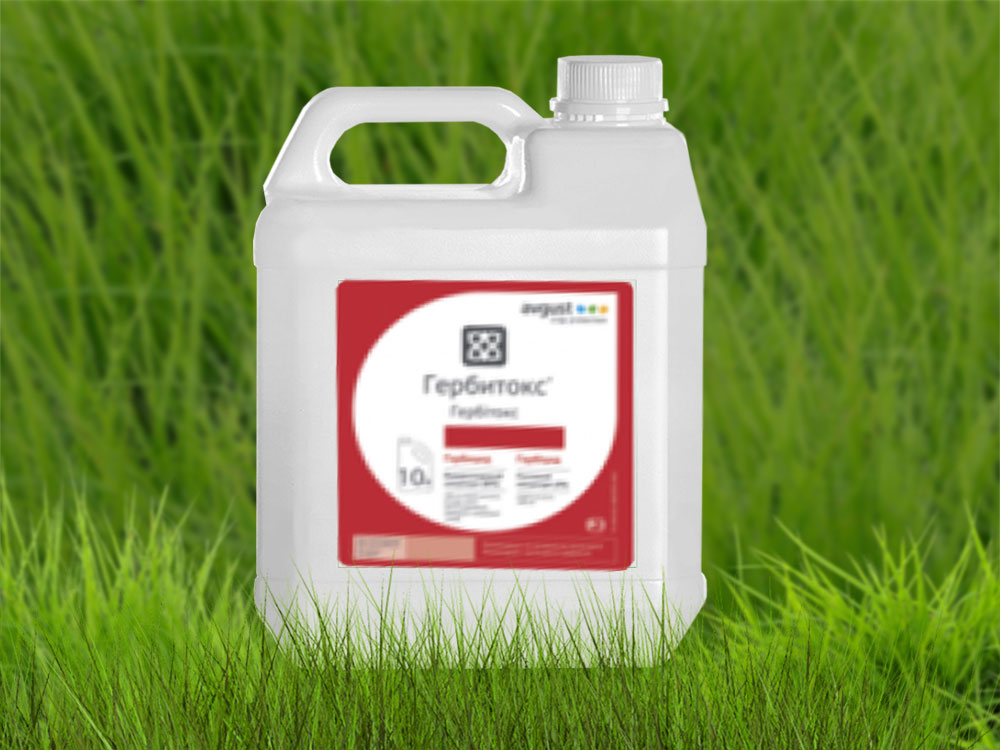
Herbitox-herbicide, the instruction for potatoes which says that the drug gets along well with other chemical weeding agents and is used when weeds are used on potatoes or grain crops, has an acidic active substance consisting of dimethylamine, potassium and sodium salts.
The manufacturer prepares the drug in 10-liter canisters with concentrate, from which a working solution is subsequently prepared. Its approximate consumption is from 200 to 300 liters per hectare.
Selective herbicide "Titus"
Titus is a herbicide whose application on potatoes has a lot of positive reviews. Specialists recommend using both of the above preparations before potato seedlings appear. But with the Titus herbicide, it is possible to process potatoes from weeds after germination. Chemical weeding is used against annual and perennial dicotyledonous weeds.
By the mode of action, the active substance of this herbicide belongs to systemic drugs - destroying the process of cell division and blocking the growth point of weed annual plants upon reaching the root system. “Titus” is the most effective for the destruction of plants such as red root weed in potatoes, common blackberry, bristle, creeping wheatgrass, beetroot, field mint, chamomile, mustard, gallows, medicinal dummy, buttercup, timothy, foxtail, wild poppy, ordinary sunflower and others
The destruction of weed grass by the drug occurs with the active substance rimsulfuron, packaged in water-soluble granules through the leaves of plants, so the soil is processed above ground. At the same time, the soil moisture indicator does not affect the effectiveness of the impact at all.
Post-emergence treatment of potatoes with Titus should occur when the sprouts have reached a length of 5 to 20 cm. A working solution for processing potato fields is induced at the rate of 50 g of chemical substance per 1 hectare of area.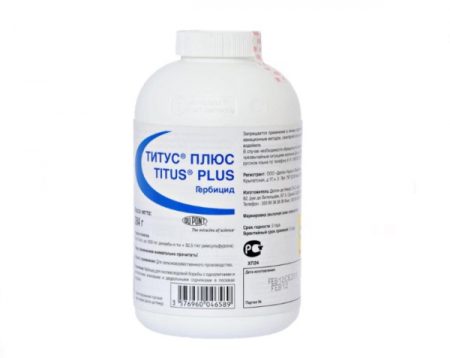
Titus herbicide, whose potato instruction does not recommend using the drug after rainfall or early in the morning when the dew has not come down. But it coexists remarkably with soil herbicides, if, due to prolonged dry weather, the impact of the latter was not effective.
The drug for weeds for potatoes "Round"
This is another fairly popular drug, which in its action is similar to the previous one. Raundal herbicide for potatoes is very effective in controlling both annual weed grass and perennial plants with a powerful root system.
It is believed that the active substance of this drug is the isopropylamine salt of glyphosate is one of the safest. At the same time, its effect on vegetation involves blocking the growth of weeds even before they begin to harm potato beds. Spraying occurs overhead, but with the defeat of not only the leaves and stems, but also the roots of the weed grass.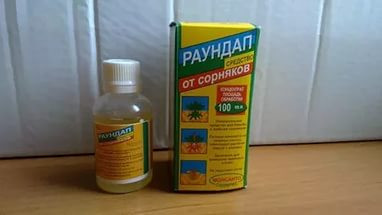
It is recommended to breed 20 - 40 ml of this herbicide in 4 liters of water, which is quite enough to process 1 hundred parts of the earth.
“Roundal” is better to spray in dry, calm weather a few hours before the expected rainfall (at least 6 hours). The optimal air temperature for processing beds is a range from 10 to 25 degrees.
This poison from potato weeds should not fall on the leaves of cultivated plants, as it can destroy the intended crop or, at least, significantly reduce it.
Lapis lazuli for potatoes
Special attention should be paid to such a drug as lapis lazuli against potato weeds. Like Raundal, Lazurite is considered a safe, highly effective drug, but it was created specifically for potatoes. Although in consequence it began to be successfully applied on tomato fields.
The active ingredient of the drug is metribuzin, concentrated in solution at the rate of 0.7 g per 1 kg.
Due to the unique composition of the herbicide, its active substances as soon as possible penetrate the weed plant through the leaves, as well as the root system. The universality of the drug also lies in the fact that lapis lazuli from weeds on potatoes can be used both before the emergence of sprouts of a cultivated plant, and after that.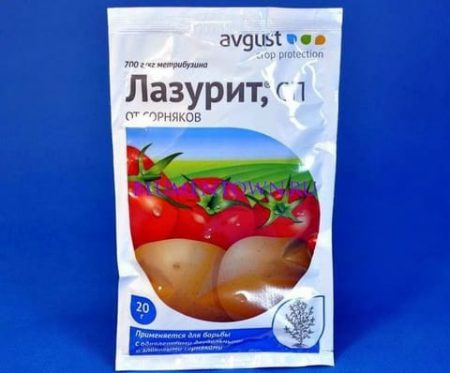
The use of lapis lazuli on potatoes should be carried out with caution. Its maximum dosage is calculated only for heavy soils. In other cases, it is better to limit yourself to a minimum amount. There are several more rules for using the herbicide for successful weeding:
Lapis lazuli for potatoes: instructions for use.
According to the recommendations of the manufacturer, the solution of the drug is not recommended for use on dry or too wet ground. Also, the substance will be ineffective on sandy soils.
If potato beds are enriched with peat or humus, then "Lapis lazuli" is better to use after the appearance of weed grass.
The duration of exposure to the drug depends on weather conditions. If the soil remains dry for 60 days, then additional processing of the beds is not worth doing. But with heavy rainfall, the lapis lazuli herbicide on potatoes needs to be used 30 days after the 1st treatment. In this case, the sprouts of harmful plants should reach about 5 cm in length.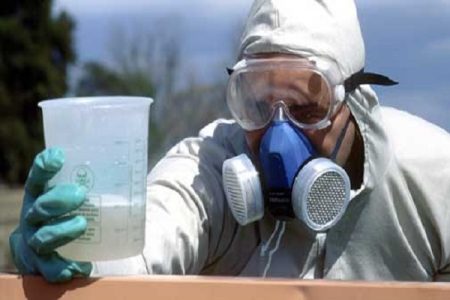
If the substance is used in a small garden, then its use is permissible after other tried and tested methods have not helped.
Potato weed control with this preparation should be done after you have thoroughly loosened and moistened the soil. And it is better if rain forecasters are predicted that day.
The maximum concentration of "Lazurite" in the spray tank should not exceed 5%. In this case, the drug dissolved in water is consumed at the rate of 2.5 liters per 1 hundred square meters of land.
The estimated consumption of "Lazurite" with a single application is from 1.7 to 1.4 kg per 1 hectare. And with a double processing method - 0.5 \ 1 kg per 1 hectare.
Spraying should be performed at a temperature of 15-20 degrees.
Processing potatoes from weeds with lapis lazuli - when should not be used?
You should not use the drug if the potato was planted too early and its seedlings were affected by frost. Moreover, you must carefully follow the processing rules if other cultivated plants are adjacent to potato beds, which can be very sensitive to the drug.
Do not spray the herbicide in close proximity to nature conservation zones, as well as fisheries. It is strictly forbidden to do this with the help of aviation.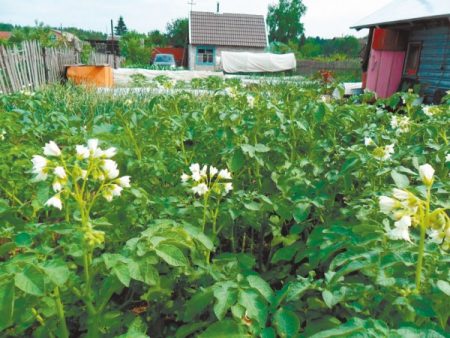
It is not recommended to use a herbicide in case potato seedlings have been affected by pests. And also, when the shoots of a cultivated plant are weak and sick.
Phytotoxic Lapis Lazuli Safety Rules
Like other weed killers for potatoes, Lapis Lazuli should be used with caution by apiary owners. Bees do not tolerate the active ingredient of the drug, so they should not be in contact with treated plants for 4 hours.
Lapis lazuli from weeds on potatoes, the instruction of which states that this substance can be a danger to surrounding plants or living things in windy weather.
In order to protect yourself as much as possible from the effects of the herbicide, you need to use special protective equipment. Namely:
- a respirator or mask with lances separately;
- special waterproof suit;
- high boots made of rubber and household gloves.
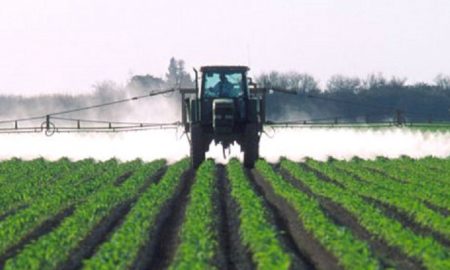
In fairness, it is worth saying that the use of "Lazurite" is justified only if other methods did not help, since the drug still belongs to the 3rd hazard class. After working on the field, it is better to take off all these clothes and take a shower.
Due to its chemical composition and safety precautions, it is forbidden to eat or smoke during spraying.
How to cook a potato weed preparation?
A convenient and detailed instruction on how to prepare a working solution contains a package of the drug. Therefore, before using Lazurite, it is best to refer to this information.
Nevertheless, we again give approximate calculations that you can focus on during the preparation of the solution:
- The herbicide in an amount of 1.7 to 1.4 kg is consumed per 1 hectare with a single use. And with a double processing method - 0.5 \ 1 kg per 1 hectare.
- If you translate this amount into liters of working solution, you get 200 \ 300 liters per 1 ha. But be careful - this rule applies only if the potato is processed with lapis lazuli, a video of which you can watch on our website. In the case of tomatoes, the ratio will be different.
- The drug is recommended to be used in minimal quantities, if we are not talking about heavy soils and perennial neglected weeds.
Finally, all potato herbicides after germination are used in a lower concentration than before.
Lapis lazuli from weeds on potatoes: reviews
Quite often, having tried many herbicides, as well as ways to control weeds and not finding the answer to the question of how to get rid of weeds on potatoes, agricultural workers find salvation in Lazurit.
Ordinary inhabitants and professional specialists are inclined to believe that after using this preparation, potatoes have no extraneous smacks or smells. And laboratory tests do not find harmful substances in cultivated plants. In general, lapis lazuli herbicide on potato seedlings has only positive reviews. Therefore, most users return to using the drug every new season.
Well, to the question of how to treat the potato field from weeds, the answer is received. But do not forget that the pests we are discussing, as mentioned at the beginning of the publication, have a high degree of “survivability”. Therefore, even the highest quality and your favorite herbicides for potatoes after germination can gradually lose their influence on weed grass. This is explained by the possibility of the plants becoming accustomed to chemical weeding, so periodically the preparations will still have to be changed.




 Description and description of varieties in Belarus with a photo
Description and description of varieties in Belarus with a photo Do I need to pick flowers from potatoes: why do they do it
Do I need to pick flowers from potatoes: why do they do it When to dig potatoes: timing and availability of new potatoes
When to dig potatoes: timing and availability of new potatoes How to grow a good potato crop: various methods and methods, planting and care
How to grow a good potato crop: various methods and methods, planting and care
Keeley
visa to latvia kaliningrad